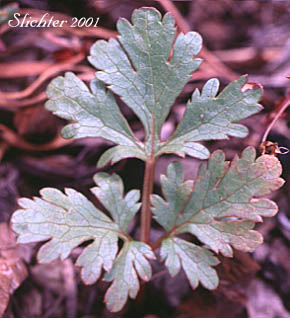 The
photo at right illustrates a lower stem leaf of Sierra snake root. Note the wide
space between the lowermost and and second pair of leaflets. Coffin Mt. Trail,
Willamette N.F.........June 13, 2001.
The
photo at right illustrates a lower stem leaf of Sierra snake root. Note the wide
space between the lowermost and and second pair of leaflets. Coffin Mt. Trail,
Willamette N.F.........June 13, 2001.
Sierra snake root is a perennial wildflower with a single stem arising from a taproot. The stem is often branched near its base into several branches which may be further branched above. The stems range from 5-50 cm high. The leaves are alternate an all found on the stems, with the lower leaves well developed and petiolate. These often appear to come separately from the ground but are indeed attached to the main stem. The blades of the lower leaves range from 1.5-4 cm long and 2-3.5 cm wide and are ternately to pinnately compound with 3-7 or more leaflets. Each leaflet is further pinnatifid with the lowest pair of leaflets separate from the rest by an entire leaf rachis or vein. The upper leaves are sessile, reduced in size and tend to have fewer leaflets.
The inflorescence is a cluster of several umbels which are spaced closely together when in bloom. A series of 6-10 oblong-ovate to lance-linear bracts subtend each umbel cluster. The flowers are yellowish and each umbel measures roughly 1 cm in diameter. Individual umbels are 10-15 flowered. The fruits are ovoid-globose in shape and measure 3-5 mm long and 2-4 mm wide, with at least the upper surface covered with stout prickles which are hooked at their tips.
The leaves and flowers of western snake root would make a nice ground cover in a dryland open forest.
Sierra snake root may be found on open to lightly wooded slopes and flatlands from low elevation to moderate elevation in the mountains.
Sierra snake root may be found from southern British Columbia south to California and east to western Montana and northwestern Wyoming. It is also found in Chile and Argentina.
In the Columbia River Gorge it may be found between the elevations of 200'-4200' from near Hamilton Mt. east to the Klickitat River.